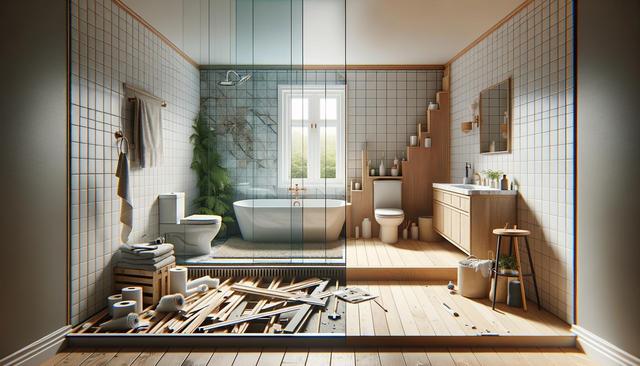Understanding the Scope of Your Remodel
The first step in estimating how long a bathroom remodel will take is understanding the project’s scope. Are you making minor cosmetic changes, or are you doing a full renovation? A simple refresh, like changing fixtures or repainting, might only take a few days. However, a complete overhaul involving plumbing, structural changes, or layout adjustments can stretch over several weeks. Knowing the difference between a cosmetic update and a full remodel is essential for setting realistic expectations.
Consider the following levels of remodeling:
- Surface-level remodel: Replacing faucets, painting walls, updating lighting – typically takes 1 to 2 weeks.
- Mid-range remodel: Includes replacing vanities, installing new flooring, and updating plumbing fixtures – expect 2 to 4 weeks.
- Full renovation: Involves tearing down walls, relocating plumbing, and custom installations – usually lasts 4 to 8 weeks or longer.
Understanding your goals and budget early helps in planning a timeline that aligns with your vision and resources.
Key Phases of a Bathroom Remodel
A bathroom remodel typically follows a series of phases, each contributing to the overall timeline. Project planning and design can take up to two weeks on their own, especially if permits are needed. After that, demolition begins, generally lasting a few days depending on the size and complexity of the bathroom. Once the space is cleared, plumbing and electrical work usually follow, taking about 5 to 10 days.
Subsequent phases include:
- Framing and drywall: 3 to 5 days, depending on the extent of structural changes.
- Flooring and tiling: 4 to 7 days, especially if custom tile patterns are involved.
- Fixture installation: Installing toilets, tubs, sinks, and vanities can take 2 to 4 days.
- Finishing touches: Painting, lighting, mirrors, and hardware installation typically require a few more days.
Each phase must be carefully coordinated, especially if multiple contractors are involved. Delays in one stage can affect the entire schedule, so flexibility is important.
Factors That Can Affect the Timeline
Several variables can influence how long your bathroom remodel will take. One of the biggest is whether you’re hiring professionals or doing the work yourself. DIY projects often take longer due to learning curves and limited free time. In contrast, hiring a contractor can expedite the process but may require scheduling around their availability.
Other factors that can affect the timeline include:
- Permit approvals: Depending on your local regulations, getting permits can add days or even weeks.
- Product availability: Special-order items like custom vanities or imported tiles can delay the project.
- Unforeseen issues: Problems like water damage, outdated wiring, or mold can extend timelines significantly.
- Weather conditions: If exterior work is involved, poor weather can cause delays.
Planning for potential setbacks and building buffer time into your schedule can help manage expectations and reduce stress.
DIY vs. Hiring a Professional
Deciding between a do-it-yourself approach and hiring professionals plays a major role in how long your bathroom remodel will take. Tackling the job yourself might save money, but it often takes longer, especially if you lack experience. Tasks like plumbing, electrical work, and tiling require precision and can be time-consuming for beginners.
On the other hand, hiring licensed professionals can streamline the process. They typically have access to skilled teams and can handle multiple tasks simultaneously. Additionally, pros are familiar with local codes and permit requirements, which helps avoid delays due to non-compliance.
When choosing a contractor, it’s important to:
- Check references and previous work
- Ensure they are licensed and insured
- Get a detailed timeline and cost estimate in writing
- Discuss availability and expected completion dates
While professional help comes with a higher upfront cost, it often results in a faster and more polished final product.
Tips for Staying on Schedule
Keeping your bathroom remodel on track requires thoughtful planning and proactive communication. Start with a clear design plan and stick to it as much as possible. Frequent changes can lead to delays and additional expenses. Create a realistic budget that includes a contingency of at least 10–15% for unexpected costs or delays.
Here are a few tips to help stay on schedule:
- Order all materials before demolition begins
- Schedule inspections in advance to avoid waiting times
- Maintain regular communication with your contractor
- Be available to make quick decisions when needed
Even with the best planning, some delays are inevitable. Being flexible and patient throughout the process can make the experience less stressful and more rewarding in the end.
Conclusion: Planning for a Smooth Remodel
Remodeling a bathroom is a significant project that requires careful planning and time management. Whether you’re making small updates or undertaking a full renovation, understanding the stages and potential delays can help set realistic expectations. By considering the scope, hiring the right professionals, and preparing for the unexpected, you can navigate your remodel with confidence and clarity. A well-planned timeline not only ensures a smoother remodeling experience but also brings you closer to enjoying your refreshed and functional bathroom space.




Leave a Reply